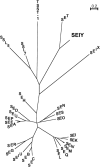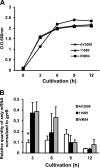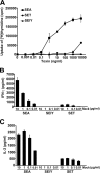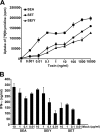Identification and Characterization of a Novel Staphylococcal Emetic Toxin
- PMID: 26231643
- PMCID: PMC4579459
- DOI: 10.1128/AEM.01873-15
Identification and Characterization of a Novel Staphylococcal Emetic Toxin
Abstract
Staphylococcal enterotoxins (SEs) produced by Staphylococcus aureus have superantigenic and emetic activities, which cause toxic shock syndrome and staphylococcal food poisoning, respectively. Our previous study demonstrated that the sequence of SET has a low level of similarity to the sequences of other SEs and exhibits atypical bioactivities. Hence, we further explored whether there is an additional SET-related gene in S. aureus strains. One SET-like gene was found in the genome of S. aureus isolates that originated from a case of food poisoning, a human nasal swab, and a case of bovine mastitis. The deduced amino acid sequence of the SET-like gene showed 32% identity with the amino acid sequence of SET. The SET-like gene product was designated SElY. In the food poisoning and nasal swab isolates, mRNA encoding SElY was highly expressed in the early log phase of cultivation, whereas a high level of expression of this mRNA was found in the bovine mastitis isolate at the early stationary phase. To estimate whether SElY has both superantigenic and emetic activities, recombinant SElY was prepared. Cell proliferation and cytokine production were examined to assess the superantigenic activity of SElY. SElY exhibited superantigenic activity in human peripheral blood mononuclear cells but not in mouse splenocytes. In addition, SElY exhibited emetic activity in house musk shrews after intraperitoneal and oral administration. However, the stability of SElY against heating and pepsin and trypsin digestion was different from that of SET and SEA. From these results, we identified SElY to be a novel staphylococcal emetic toxin.
Copyright © 2015, American Society for Microbiology. All Rights Reserved.
Figures





References
-
- Thomas DY, Jarraud S, Lemercier B, Cozon G, Echasserieau K, Etienne J, Gougeon M, Lina G, Vandenesch F. 2006. Staphylococcal enterotoxin-like toxins U2 and V, two new staphylococcal superantigens arising from recombination within the enterotoxin gene cluster. Infect Immun 74:4724–4734. doi:10.1128/IAI.00132-06. - DOI - PMC - PubMed
Publication types
MeSH terms
Substances
Associated data
- Actions
LinkOut - more resources
Full Text Sources

